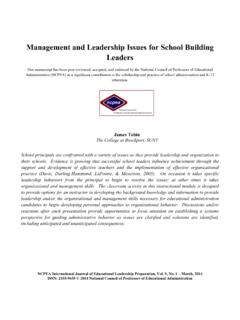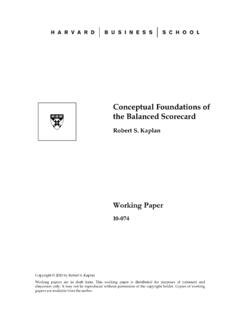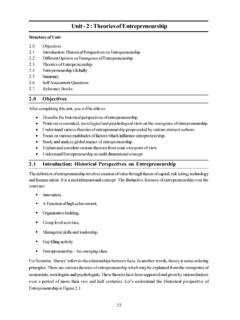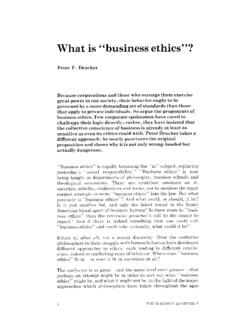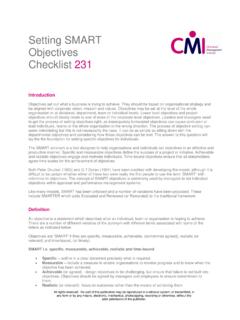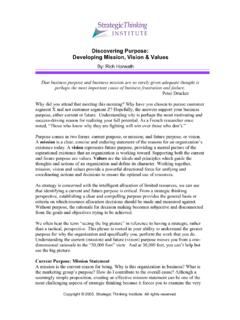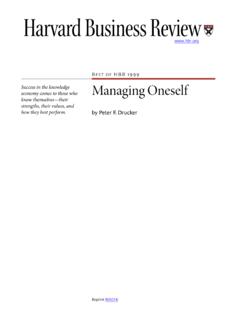Transcription of PhD Research Proposal - Business Models Community
1 PhD Research Proposal Doctoral Programme in Business Management Conceptualising the Business model innovation construct The investigation of innovation-related capabilities and process design of Business model transformation based on a service-dominant logic paradigm Paul-Peter Knopf Advisor: Word Count: Date of submission: PhD Research Proposal Page | 2 Table of Contents 1. Literature Review .. 3 Business Model Construct .. 3 Business Model Innovation .. 3 2. Conceptual Background .. 4 Service-dominant logic as a vehicle for Business Model Innovation.
2 4 3. Research Gaps .. 7 4. Research Context: Airline 8 Business Models in the airline industry .. 8 Convergence of Business Models .. 9 Commoditisation of the Airline Service Product .. 9 Innovation in the Context of the Airline Industry .. 10 5. Research Programme .. 11 Objectives .. 11 Research Questions .. 12 Methodology .. 12 Sample .. 13 Data Collection .. 14 Data Analysis .. 14 Framework-building process .. 14 6. Contribution to Knowledge .. 15 7. References .. 16 PhD Research Proposal Page | 3 1. Literature Review Business Model Construct The Business model construct has been defined variously, differing in terms of components, scope and theoretical underpinnings (Lambert & Davidson, 2013).
3 Teece (2010, p. 191) broadly defines the construct as the design or architecture of the value creation, delivery and capture mechanisms employed . In line with these reflections, other authors suggest additional dimensions to the theoretical discourse of Business Models , such as the customer interface (Baden-Fuller & Haefliger, 2013), social (Yunus, Moingeon & Lehmann-Ortega, 2010) or financial elements (Chesbrough & Rosenbloom, 2002). Moreover, the Business model construct was interpreted differently in terms of its scope. Several conceptualisations restrict its scope to the boundaries of the company itself (Osterwalder & Pigneur, 2009; Afuah, 2004), while other propositions consider the Business model construct from a network perspective (Zott & Amit, 2010).
4 Finally, divergent views among scientists exist with regard to the theoretical sovereignty of the Business model construct. Hence, several academics consider the Business model construct as a subordinated concept to strategy that is the direct result of strategy but is not, itself, a strategy (Casadesus-Masanell & Ricart, 2010, p. 212). Consequently, the design of the Business model is the transformation of strategy into practice (Velu, 2014). In contrary, the construct is defined as an objective concept that is independent from strategy (Baden-Fuller & Morgan, 2010).
5 Business Model Innovation Enterprises are increasingly exposed to highly competitive and fast changing Business environments (Van Oosterhout, Waarts, & van Hillegersberg, 2006). External factors, such as globalisation and competitive pressures, or internal influences, for instance a change in strategy, force companies to renew their Business Models (Verma & Jayasimha, 2014). PhD Research Proposal Page | 4 Business model innovation has a deep systemic impact on an organisation (Velu & Stiles, 2013) and involves major risk for the company (Euchner & Ganguly, 2014) because it redefines the value creation and capture mechanisms of a firm (Teece, 2010).
6 Transformation of the Business model occurs when a dimension of the construct is manipulated which will lead to a new value proposition, the reallocation of key resources and processes and a reformulation of the profit formula (Johnson, Christensen, & Kagermann, 2008). 2. Conceptual Background Service-dominant logic as a vehicle for Business Model Innovation Service dominant logic (SDL) claims that all economic activities are a manifestation of service. Therefore, physical products are a materialised form of service and perceived as bundles of human knowledge (Maglio & Spohrer, 2013).
7 A Firm is considered as an assortment of operand and operant resources ( people, technologies, organisations and information) (Spohrer, Maglio, Bailey, & Gruhl, 2007). As the enterprise cannot define value for its value network, the entity dynamically configures its resources to engage in collaborative activities with its external environment in order to shape value propositions with mutual agreement (Lusch, 2011). Accordingly, customers, suppliers and other economic entities are cocreators and resource integrators in the value proposition design (Ordanini, & Parasuraman, 2011).
8 Operant resources, such as people and businesses, applying skills, competences, capabilities and knowledge, can facilitate the interaction between company and value network and create competitive advantage. Technology can assist as a communicative and relationship building medium enabling interaction and collaboration between actors in the eco-system in the process of value cocreation (Lusch, 2011). PhD Research Proposal Page | 5 Service-dominant logic enables the investigation of Business model innovation from a service perspective because it conceptually roots in the service sector and does not adapt a manufacturing mind set.
9 This has major implications on the nature, process and outcome of innovation in a service context: 1) Innovation is an open process surpassing a company s boundaries. The collaborative aspect inherent to SDL characterises innovation as an activity that is outward oriented towards the external environment (Chesbrough, 2006). The interaction between customers, suppliers and employees is critical to the realisation of innovation (Verma & Jayasimha, 2014). Accordingly, the customer possesses an innovative capacity (Thomke & Hippel, 2002). As Business model transformation is a learning process, the engagement of customers can positively contribute to diminish the risk associated with it.
10 (Euchner & Ganguly, 2014). 2) Knowledge-oriented dynamic capabilities determine the company s innovative capacity and potential. SDL stresses the importance of operant resources, and considers knowledge as the principal source to achieve competitive advantage (Lusch, 2011). Similarly, drucker (2009) argues that knowledge is the dominant- and perhaps only source of comparative advantage ( ). A company utilizes knowledge sources, such as external ( customers, suppliers) and internal sources ( employees) to extend its knowledge base (Nonaka, Toyama, & Konno, 2000).


